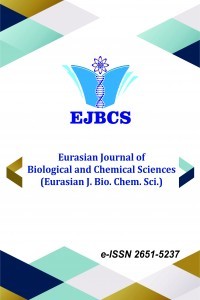The usage of discarded battery coals as electrodes and improving their hydrogen gas production performances by impregnation with Zr and Ce metals
The usage of discarded battery coals as electrodes and improving their hydrogen gas production performances by impregnation with Zr and Ce metals
energy, battery, hydrogen, electrolysis cerium,
___
- Demir E, Akbayrak S, Önal AM, Özkar S 2018. Titania, zirconia and hafnia supported ruthenium(0) nanoparticles: Highly active hydrogen evolution catalysts. J Colloid Interf Sci 531: 570-577.
- Ghodsi FE, Tepehan FZ, Tepehan GG 2011. Derivation of the optical constants of spin coated CeO2–TiO2–ZrO2 thin films prepared by sol–gel route. J Phys Chem Solids 72: 761–767.
- Kadier A, Simayi Y, Abdeshahian P, Azman NF, Chandrasekhar K, Kalil S 2016. A comprehensive review of microbial electrolysis cells (MEC) reactor designs and configurations for sustainable hydrogen gas production. Alexandria Eng J 55: 427–443.
- Kaseem M, Ko YG 2018. A novel composite system composed of zirconia and LDHs film grown on plasma electrolysis coating: Toward a stable smart coating. Ultrason Sonochem 49: 316-324.
- Kumar SS, Ramakrishna SUB, Reddy DS, Bhagawan D, Himabindu V 2017. Synthesis of Polysulfone and zirconium oxide coated asbestos composite separators for alkaline water electrolysis. Int J Chemical Eng & Process Tech 3: 1035/1-6.
- Lee B, Chae H, Choi NH, Moon C, Moon S, Lim H 2017. Economic evaluation with sensitivity and profitability analysis for hydrogen production from water electrolysis in Korea. Int J Hydrogen Energy 42: 6462–6471.
- Lei Q, Wang B, Wang P, Liu S 2019. Hydrogen generation with acid/alkaline amphoteric water electrolysis. J Energy Chem 38: 162-169.
- Lim H 2015. Hydrogen selectivity and permeance effect on the water gas shift reaction (WGSR) in a membrane reactor. Korean J Chem Eng 32: 1522–1527.
- Mujeebu MA 2016. Hydrogen and syngas production by superadiabatic combustion-A review. Appl Energy 173: 210-224.
- Ni M, Leung MKH, Leung DYC 2008. Technological development of hydrogen production by solid oxide electrolyzer cell (SOEC). Int J Hydrogen Energy 33: 2337–2354.
- Polliotto V, Albanese E, Livraghi S, Agnoli S, Pacchioni G, Giamello E 2018. Structural, electronic and photochemical properties of cerium-doped zirconium titanate. Catal Today (In press, corrected proof, Available online 14 October 2018)
- Rathinam NK, Sani RK, Salem D, Rewiring Extremophilic Electrocatalytic Processes for Production of Biofuels and Value-Added Compounds from Lignocellulosic Biomass. In: R. Sani, N. Krishnaraj Rathinam (eds), Extremophilic Microbial Processing of Lignocellulosic Feedstocks to Biofuels, Value-Added Products, and Usable Power. Springer, Cham. 2018, pp. 229-245.
- Sapountzi MF, Gracia MJ, Weststrate CJKJ, Hans OA, Niemantsverdriet, JWH 2017. Electrocatalysts for the generation of hydrogen, oxygen and synthesis gas. Prog Energy Combust Sci 58: 1–35.
- Seyitoglu SS, Dincer I, Kilicarslan A 2017. Energy and exergy analyses of hydrogen production by coal gasification. Int J Hydrogen Energy 42: 2592–600.Sivagurunathan P, Kumar G, Kim SH, Kobayashi T, Xu KQ, Guo W 2016. Enhancement strategies for hydrogen production from wastewater: a review. Curr Org Chem 20: 2744-2752.
- Wang J, Wang T, Yu L, Wei T, Hu X, Ye Z, Wang Z, Buckley CE, Yao J, Marnellos GE, Dong D 2019. Catalytic CeO2 washcoat over microchanneled supporting cathodes of solid oxide electrolysis cells for efficient and stable CO2 reduction. J Power Sources 412: 344-349.
- Zeng K, Zhang D 2010. Recent progress in alkaline water electrolysis for hydrogen production and applications. Prog Energy Combust Sci 36: 307–26.
- Züttel A 2004. Hydrogen storage methods. Naturwissenschaften 91: 157–172.
- Yayın Aralığı: Yılda 2 Sayı
- Başlangıç: 2018
- Yayıncı: Muhammet DOĞAN
İmge KUNTER, Niloufar ZABİB, Marianna NAJJAR, Yelin SUBASI, Gonul SAHİN
The Effect of Repeated Doses of Ketamine on Hematological Parameters in Rats
LPS’nin böbrek DNA’sı üzerine akut toksik etkisi ve apilarnilin koruyucu rolü
Züleyha DOĞANYİĞİT, Sibel SİLİCİ, Emin KAYMAK, Aslı OKAN, Dilek PANDIR
